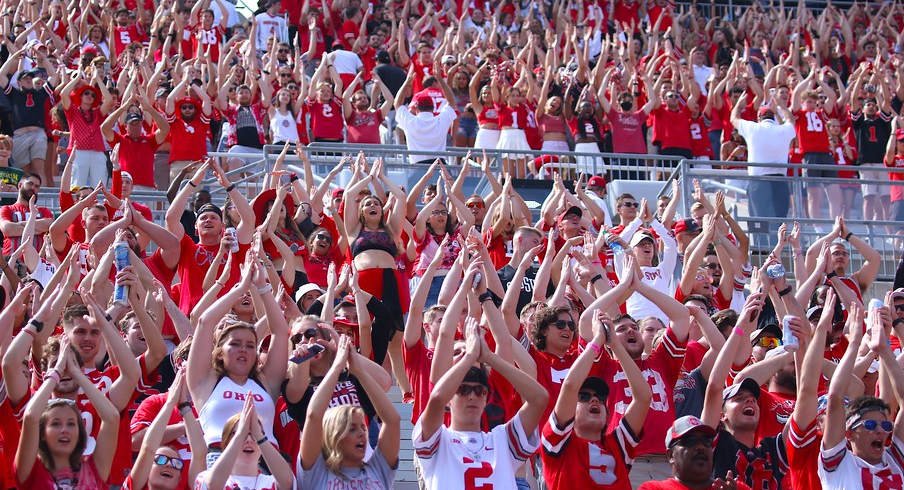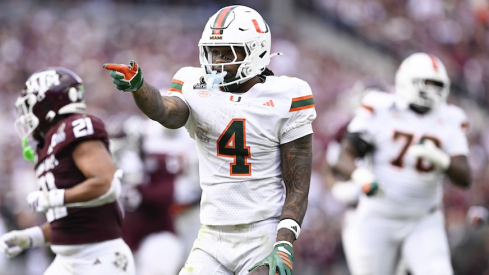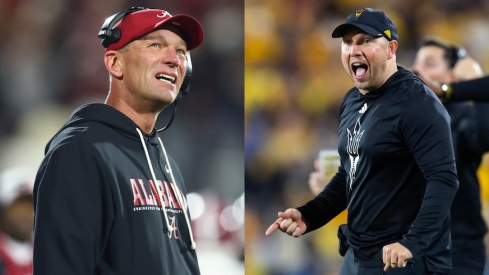On September 10th, 2011, the Ohio State Buckeyes took the field against the mighty Toledo Rockets. After a hard fought game in which Toledo had over 100 yards in penalties and screwed up two field goal attempts, the Buckeyes proudly placed a 27-22 victory on their mantle as Joe Bauserman led them to glory by completing 16 passes for 189 yards. This ended up being the best passing performance of his 21 game Ohio State career, and 105,016 souls were lucky enough to witness history. Oh, and there were 13 punts.
I've been wringing my hands about attendance for years.
Not because I think that Ohio State needs to hit some kind of arbitrary number for prestige reasons (in part because if that's the game you want to play, you're going to have to argue with Tennessee fans, which is like trying to debate a toddler about the finer points of not touching a hot stove), but because I think that declining attendance is indicative of a larger problem that college football at large and Ohio State specifically needs to grapple with. To condense many articles' worth of teeth-gnashing, college football needs to fundamentally rethink its relationship with fans. Schools need to start viewing fans as customers that need to be catered to, rather than a captive audience that will show up regardless because of some amorphous familial attachment to a university.
But I digress, because instead of complaining about bench seating designed for the ass space of a malnourished Dickensian street urchin or the two and a half toilets available in Ohio Stadium, I want to talk about some of the potentially positive aspects of declining attendance. Well, besides not being forced to occupy the same physical space as a guy slowly, shakily dipping a giant pretzel into a slippery plastic cup filled with nacho cheese (that guy is me, I'm sorry).
And yes, it's not just Ohio State: in-person college football attendance is declining across the board. As Dennis Dodd points out, this is a multi-year issue for the sport.
For an aging fan base facing rising ticket, parking and concession prices, it's easy to go to a default setting on game day. For younger fans with shorter attention spans, it's about keeping their attention, period. [...]
Last season marked the seventh straight year and ninth year in the last 10 that FBS attendance has declined.
Dodd's dig on The Youths Of Today With Their TikToks And Twitters isn't necessarily wrong, at least in the sense that yeah, there are a lot of ways that someone might want to spend their time other than sous vide-ing in a broiling stadium for four hours. But what's fascinating is just how quickly this attitude has emerged, because it was just 10 years ago that 105,000 Buckeye fans dutifully trudged to Ohio Stadium to watch a 5-3 Ohio State team take on a 1-8 Indiana Hoosiers squad. This was weeks after the aforementioned Toledo game, and while it was at least a more interesting way to spend a fall Saturday (the Buckeyes had three players with at least 100 yards rushing which is cool and neat), no sane person should've had any reasonable expectation that it would be.
And that is what I think has changed, for the better. Ohio State can't count on sellouts anymore, and that's going to force them to get increasingly creative in their attempt to get butts in the seats of Ohio Stadium.
A few stats, and yes, the usual COVID caveats apply: by Ohio State's own numbers, Buckeye football sold out exactly one of seven home games in 2021, against Penn State. They failed to admit more than 100,000 fans three times, including against Tulsa. That particular game saw Ohio State have their lowest attendance in a non-global pandemic year since 1971, which is a year that only exists hypothetically because archaeologists haven't discovered records that go back that far.
Per Ohio State, approximately 20,000 people who had tickets to Saturday's game vs. Tulsa did not attend. Attendance for Saturday's game was just 76,540, lowest for an Ohio State home game since 1971 (excluding 2020).
— Dan Hope (@Dan_Hope) September 21, 2021
Tickets still available for this week's game against Akron.
The Tulsa game, you'll remember, came after a humiliating loss at home against Oregon, and sent people scrambling for explanations as to why nobody wanted to see the home team. Ticket prices too high? Not enough bathrooms? Bad weather? Seats too small or uncomfortable? Not enough food or drink options?
That these questions are even being asked, by actual important people and not just jaded Internet Guys, is significant. Dodd spills a lot of ink detailing how the powerbrokers of the college sports world are freaking out about the lack of fans in seats, but that's exactly the point: maybe now they'll be forced to listen and adapt to the wants and needs of fans, from stadium amenities to ticket prices, because we're starting to see more and more people choose a couch over a stadium.


